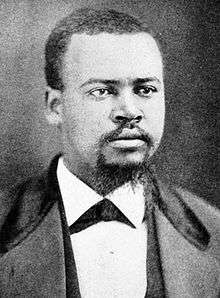John Adams Hyman
| John Adams Hyman | |
|---|---|
 | |
| Member of the U.S. House of Representatives from North Carolina's 2nd district | |
|
In office March 4, 1875 – March 3, 1877 | |
| Preceded by | Charles R. Thomas |
| Succeeded by | Curtis Hooks Brogden |
| Member of the North Carolina Senate | |
|
In office 1868–1874 | |
| Personal details | |
| Born |
July 23, 1840 near Warrenton, North Carolina |
| Died |
September 14, 1891 (aged 51) Washington, D.C. |
| Political party | Republican |
John Adams Hyman (July 23, 1840 – September 14, 1891) was a Republican U.S. Congressman from North Carolina from 1875 to 1877, the first African American to represent the state in the House of Representatives. He was elected from North Carolina's 2nd congressional district, including counties in the northeast around New Bern.
Early life and education
Born into slavery in 1840 near Warrenton, North Carolina, Hyman did not receive any formal education as a child. By 1861, he was working as a janitor for a jeweler named King in Warrenton. King was from the free state of Pennsylvania and taught Hyman to read and write; when this was discovered by whites in town, they ran off the man and his wife. When Hyman persisted in trying to gain an education, at the age of 21 he was sold downriver to a new master in Alabama.[1] In twenty-five years as a slave, Hyman was sold at least eight times.[1]
Post-Civil War political career
After the American Civil War and the emancipation of enslaved people, Hyman returned to North Carolina in 1865. He worked as a farmer and pursued elementary studies.
Recognized for his leadership, Hyman was chosen as a delegate to the State equal rights convention in 1865 and to the State constitutional convention in 1868. Hyman was elected to the North Carolina Senate, where he served from 1868 to 1874 in the Reconstruction-era legislature.
In 1874, Hyman was elected as a Republican to the 44th United States Congress from North Carolina's 2nd congressional district, running against Democrat Garland H. White. He "had swept Craven and seven other counties in the newly created district that became known as the 'Black Second.'"[2] Democrats in the legislature had established the district to try to reduce black influence in politics in other parts of the state, as this was a black-majority area. The freedmen and previously free blacks elected all but two Republican representatives for the next quarter century. Hyman served for one term (March 4, 1875 – March 3, 1877). After unsuccessfully running for the Republican renomination to Congress in 1876 and losing to Brogden, the immediate past governor, Hyman returned to agricultural pursuits.
By 1877, New Bern had become a black-majority town; blacks elected representatives to the board of aldermen and the Craven County Commission, until the Democratic-dominated state legislature withdrew the county's authority to govern itself. The county continued to elect at least one black legislator each session to the state house for another decade, as did other majority-black counties in the northeast part of the state.[3]
Hyman was appointed as special deputy collector of internal revenue for the fourth district of North Carolina from July 1, 1877 to June 30, 1878.
He moved to Washington, D.C. after being accused of misappropriating church funds and criticized by fellow church members for operating a liquor store. He worked for the United States Postal Service and for the United States Department of Agriculture in Washington, where he died on September 14, 1891. He was buried in Columbian Harmony Cemetery.
Marriage and family
Hyman was survived by his wife and four children.
Legacy and honors
- A North Carolina historical marker has been installed in Warrenton, about a block from Hyman's former homesite.[4]
See also
References
- 1 2 Reid, George (Summer 1979). "Four in Black: North Carolina's Black Congressmen from 1874 to 1901". Journal of Negro History (Vol. 64, No. 3).
- ↑ Benjamin R. Justesen, George Henry White: An Even Chance in the Race of Life (Baton Rouge: Louisiana State University Press, 2001): 37-38
- ↑ Justesen (2001), George Henry White, p. 38
- ↑ "John Adams Hyman", North Carolina Historical Marker
- United States Congress. "John Adams Hyman (id: H001025)". Biographical Directory of the United States Congress. Retrieved on 2009-04-26
- "Hyman rose from slavery to serve in U.S. Congress", Littleton Observer
| United States House of Representatives | ||
|---|---|---|
| Preceded by Charles Thomas |
Member of the U.S. House of Representatives from North Carolina's 2nd congressional district 1875–1877 |
Succeeded by Curtis H. Brogden |